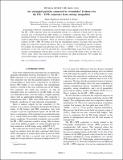| dc.contributor.author | Gharibyan, Hrant | |
| dc.contributor.author | Penna, Robert | |
| dc.date.accessioned | 2014-08-22T15:51:20Z | |
| dc.date.available | 2014-08-22T15:51:20Z | |
| dc.date.issued | 2014-03 | |
| dc.date.submitted | 2013-08 | |
| dc.identifier.issn | 1550-7998 | |
| dc.identifier.issn | 1550-2368 | |
| dc.identifier.uri | http://hdl.handle.net/1721.1/88981 | |
| dc.description.abstract | If spacetime is built out of quantum bits, does the shape of space depend on how the bits are entangled? The ER = EPR conjecture relates the entanglement entropy of a collection of black holes to the cross sectional area of Einstein-Rosen (ER) bridges (or wormholes) connecting them. We show that the geometrical entropy of classical ER bridges satisfies the subadditivity, triangle, strong subadditivity, and Cadney-Linden-Winter inequalities. These are nontrivial properties of entanglement entropy, so this is evidence for ER = EPR. We further show that the entanglement entropy associated with classical ER bridges has nonpositive tripartite information. This is not a property of entanglement entropy, in general. For example, the entangled four qubit pure state |GHZ[subscript 4]⟩ = (|0000⟩ + |1111⟩)/√2 has positive tripartite information, so this state cannot be described by a classical ER bridge. Large black holes with massive amounts of entanglement between them can fail to have a classical ER bridge if they are built out of |GHZ[subscript 4]⟩ states. States with nonpositive tripartite information are called monogamous. We conclude that classical ER bridges require monogamous EPR correlations. | en_US |
| dc.description.sponsorship | MIT Department of Physics Pappalardo Program | en_US |
| dc.language.iso | en_US | |
| dc.publisher | American Physical Society | en_US |
| dc.relation.isversionof | http://dx.doi.org/10.1103/PhysRevD.89.066001 | en_US |
| dc.rights | Article is made available in accordance with the publisher's policy and may be subject to US copyright law. Please refer to the publisher's site for terms of use. | en_US |
| dc.source | American Physical Society | en_US |
| dc.title | Are entangled particles connected by wormholes? Evidence for the ER = EPR conjecture from entropy inequalities | en_US |
| dc.type | Article | en_US |
| dc.identifier.citation | Gharibyan, Hrant, and Robert F. Penna. “Are Entangled Particles Connected by Wormholes? Evidence for the ER = EPR Conjecture from Entropy Inequalities.” Phys. Rev. D 89, no. 6 (March 2014). © 2014 American Physical Society | en_US |
| dc.contributor.department | Massachusetts Institute of Technology. Department of Physics | en_US |
| dc.contributor.department | MIT Kavli Institute for Astrophysics and Space Research | en_US |
| dc.contributor.mitauthor | Gharibyan, Hrant | en_US |
| dc.contributor.mitauthor | Penna, Robert | en_US |
| dc.relation.journal | Physical Review D | en_US |
| dc.eprint.version | Final published version | en_US |
| dc.type.uri | http://purl.org/eprint/type/JournalArticle | en_US |
| eprint.status | http://purl.org/eprint/status/PeerReviewed | en_US |
| dspace.orderedauthors | Gharibyan, Hrant; Penna, Robert F. | en_US |
| dc.identifier.orcid | https://orcid.org/0000-0003-3932-6174 | |
| mit.license | PUBLISHER_POLICY | en_US |
| mit.metadata.status | Complete | |
